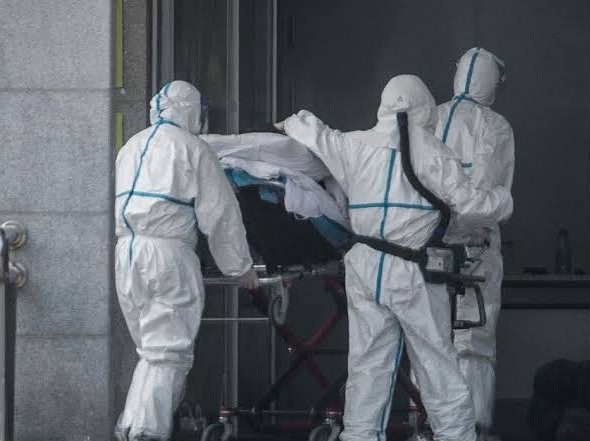New Delhi (NVI): As coronavirus continues to claim lives across the globe, there is a lingering question about how to dispose of the bodies of infected people, amid various theories doing rounds.
According to the World Health Organisation (WHO), there is no evidence, till date, of persons having become infected from exposure to the bodies of persons who died from COVID-19.
However, it says the advisory is subject to revision as new evidence becomes available.
As of now, it has issued interim guidance for all those, including managers of health care facilities and mortuaries, religious and public health authorities, and families, who tend to the bodies of persons who have died of suspected or confirmed COVID-19.
The interim guidance report – ‘Infection Prevention and Control for the safe management of a dead body in the context of COVID-19’ — talks about standard operating procedures while dealing with a COVID-19 dead body and all precautions to be taken during cremation or burial of such bodies.
WHO says people, who have died from COVID-19, can be buried or cremated, while underlining that hasty disposal of a dead from COVID-19 should be avoided.
“The dignity of the dead, their cultural and religious traditions, and their families should be respected and protected throughout,” the global health body says.
“The safety and well-being of everyone who tends to bodies should be the first priority. Before attending to a body, people should ensure that the necessary hand hygiene and personal protective equipment (PPE) supplies are available,” says the report.
The hand hygiene involves the use of an alcohol-based hand rub, running water, soap and disposable towel for hand drying (paper or tissue).
Personal protective equipment would include:
*Gloves (single use, heavy duty gloves)
*Boots
*Waterproof plastic apron
*Long sleeve gowns
*Anti-fog goggles
*Face shield
*Medical mask
*N95 or similar level respirator (for aerosol-generating procedures only)
WHO has also elaborated on preparing and packing the body for transfer from a patient room to an autopsy unit, mortuary, crematorium, or burial site. The guidelines call for ensuring that personnel who interact with the body from health care or mortuary staff, or the burial team should apply standard precautions including hand hygiene before and after interaction with the body, and the environment.
Such persons should use appropriate PPE according to the level of interaction with the body, including a gown and gloves. “If there is a risk of splashes from the body fluids or secretions, personnel should use facial protection, including the use of face shield or goggles and medical mask,” it says. Other recommendations in this direction include:
* Prepare the body for transfer including removal of all lines, catheters and other tubes.
* Ensure that any body fluids leaking from orifices are contained
* Keep both the movement and handling of the body to a minimum
*Wrap body in cloth and transfer it as soon as possible to the mortuary area
–There is no need to disinfect the body before transfer to the mortuary area
– Body bags are not necessary, although they may be used for other reasons (e.g. excessive body fluid leakage)
*No special transport equipment or vehicle is required
The health body further recommends that if the family wishes only to view the body and not touch it, they may do so, using standard precautions at all times including hand hygiene. “Give the family clear instructions not to touch or kiss the body,” WHO advises persons involved in handling the dead body. Other recommendations include:
* Embalming is not recommended to avoid excessive manipulation of the body
* Adults over 60 years and immunosuppressed persons should not directly interact with the body.
With respect to the burial of COVID-19 dead bodies, WHO says advises to confirm national and local requirements that may dictate the handling and disposition of the remains. The recommendation has been made as handling and cremation of a dead body is a sensitive task and must be done in the knowldege of family or commmunity members, while keeping their cultural practices also in mind.
Besides this, the advisory also calls for following safety procedures during autopsy, including engineering and environmental controls. “Perform autopsies in an adequately ventilated room, i.e. at least natural ventilation with at least 160L/s/patient air flow or negative pressure rooms with at least 12 air changes per hour (ACH) and controlled direction of air flow when using mechanical ventilation. Only a minimum number of staff should be involved in the autopsy,” it says.
“Environmental surfaces, where the body was prepared, should first be cleaned with soap and water, or a commercially prepared detergent solution,” WHO says while recommending that the mortuary must be kept clean and properly ventilated at all times.
While WHO appeals for avoiding congregations and gatherings during death ceremonies, it suggests that family and friends may view the body after it has been prepared for burial, in accordance with customs.
“They should not touch or kiss the body and should wash their hands thoroughly with soap and water following the viewing; physical distancing measures should be strictly applied (at least 1 m between people),” it recommends.
However, the report says that the belongings of the deceased person do not need to be burned or otherwise disposed of.
“They should be handled with gloves and cleaned with a detergent followed by disinfection with a solution of at least 70% ethanol or 0.1% (1000 ppm) bleach,” it says adding that clothing and other fabric belonging to the deceased should be machine washed with warm water at 60−90°C (140−194°F) and laundry detergent.
“If machine washing is not possible, linens can be soaked in hot water and soap in a large drum using a stick to stir and being careful to avoid splashing. The drum should then be emptied, and the linens soaked in 0.05% chlorine for approximately 30 minutes. Finally, the laundry should be rinsed with clean water and the linens allowed to dry fully in sunlight,” it says.








